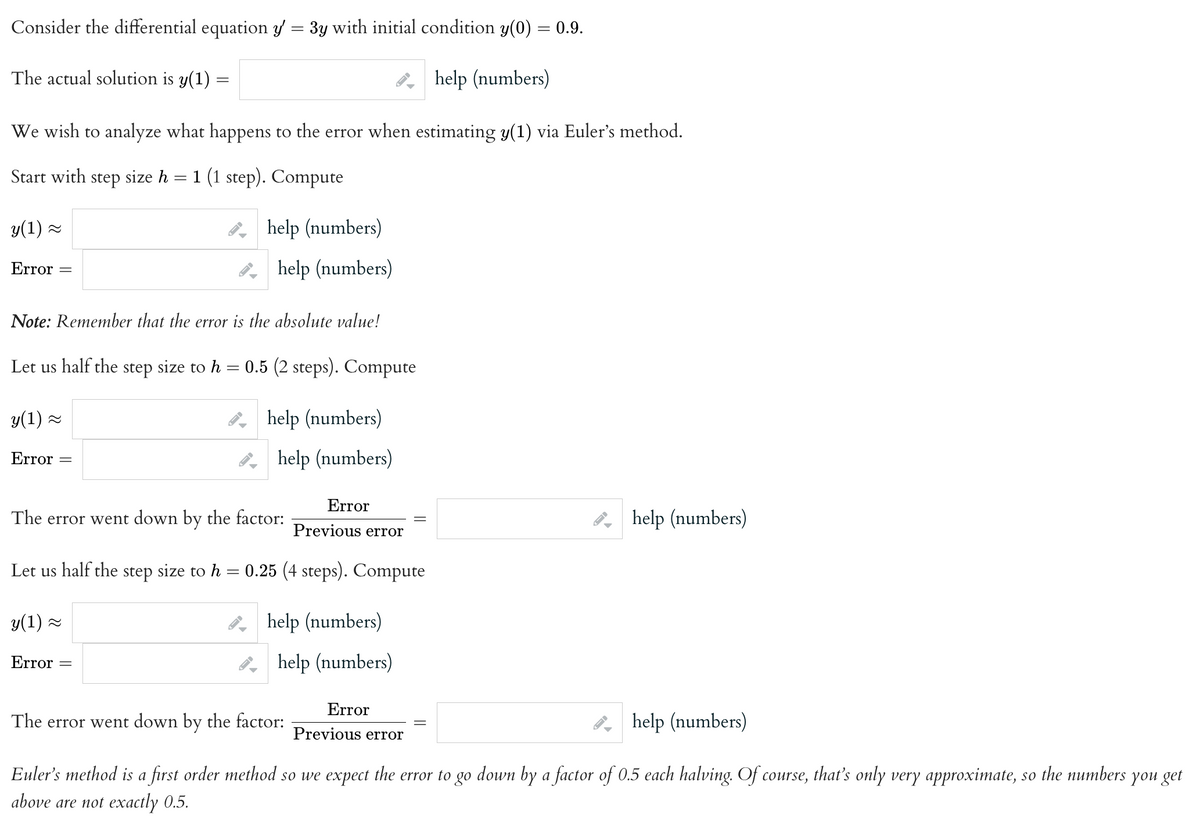Consider the differential equation y = 3y with initial condition y(0) = 0.9. The actual solution is y(1) = help (numbers) We wish to analyze what happens to the error when estimating y(1) via Euler's method. Start with step size h = 1 (1 step). Compute y(1) ≈ Error = Note: Remember that the error is the absolute value! Let us half the step size to h = 0.5 (2 steps). Compute help (numbers) help (numbers) y(1) Error = help (numbers) help (numbers) The error went down by the factor: Error Previous error Let us half the step size to h = 0.25 (4 steps). Compute y(1) ≈ Error = help (numbers) help (numbers) Error Previous error help (numbers) The error went down by the factor: help (numbers) Euler's method is a first order method so we expect the error to go down by a factor of 0.5 each halving. Of course, that's only very approximate, so the numbers you get above are not exactly 0.5.
Consider the differential equation y = 3y with initial condition y(0) = 0.9. The actual solution is y(1) = help (numbers) We wish to analyze what happens to the error when estimating y(1) via Euler's method. Start with step size h = 1 (1 step). Compute y(1) ≈ Error = Note: Remember that the error is the absolute value! Let us half the step size to h = 0.5 (2 steps). Compute help (numbers) help (numbers) y(1) Error = help (numbers) help (numbers) The error went down by the factor: Error Previous error Let us half the step size to h = 0.25 (4 steps). Compute y(1) ≈ Error = help (numbers) help (numbers) Error Previous error help (numbers) The error went down by the factor: help (numbers) Euler's method is a first order method so we expect the error to go down by a factor of 0.5 each halving. Of course, that's only very approximate, so the numbers you get above are not exactly 0.5.
Advanced Engineering Mathematics
10th Edition
ISBN:9780470458365
Author:Erwin Kreyszig
Publisher:Erwin Kreyszig
Chapter2: Second-order Linear Odes
Section: Chapter Questions
Problem 1RQ
Related questions
Question
100%
Ordinary Diff Equations

Transcribed Image Text:Consider the differential equation y' = 3y with initial condition y(0) = 0.9.
The actual solution is y(1)
help (numbers)
We wish to analyze what happens to the error when estimating y(1) via Euler's method.
Start with step size h
=
1 (1 step). Compute
y(1) ≈
Error: =
Note: Remember that the error is the absolute value!
y(1) ≈
Error =
=
Let us half the step size to h = 0.5 (2 steps). Compute
help (numbers)
help (numbers)
y(1) ≈
Error
=
The error went down by the factor:
Error
Previous error
Let us half the step size to h = 0.25 (4 steps). Compute
help (numbers)
help (numbers)
help (numbers)
help (numbers)
Error
Previous error
help (numbers)
The error went down by the factor:
help (numbers)
Euler's method is a first order method so we expect the error to go down by a factor of 0.5 each halving. Of course, that's only very approximate, so the numbers you get
above are not exactly 0.5.
Expert Solution
This question has been solved!
Explore an expertly crafted, step-by-step solution for a thorough understanding of key concepts.
This is a popular solution!
Trending now
This is a popular solution!
Step by step
Solved in 5 steps with 4 images

Recommended textbooks for you

Advanced Engineering Mathematics
Advanced Math
ISBN:
9780470458365
Author:
Erwin Kreyszig
Publisher:
Wiley, John & Sons, Incorporated

Numerical Methods for Engineers
Advanced Math
ISBN:
9780073397924
Author:
Steven C. Chapra Dr., Raymond P. Canale
Publisher:
McGraw-Hill Education

Introductory Mathematics for Engineering Applicat…
Advanced Math
ISBN:
9781118141809
Author:
Nathan Klingbeil
Publisher:
WILEY

Advanced Engineering Mathematics
Advanced Math
ISBN:
9780470458365
Author:
Erwin Kreyszig
Publisher:
Wiley, John & Sons, Incorporated

Numerical Methods for Engineers
Advanced Math
ISBN:
9780073397924
Author:
Steven C. Chapra Dr., Raymond P. Canale
Publisher:
McGraw-Hill Education

Introductory Mathematics for Engineering Applicat…
Advanced Math
ISBN:
9781118141809
Author:
Nathan Klingbeil
Publisher:
WILEY

Mathematics For Machine Technology
Advanced Math
ISBN:
9781337798310
Author:
Peterson, John.
Publisher:
Cengage Learning,

